
The Hornet genus is part of the Real wasp family, and therefore these insects are rightfully considered the closest relatives of ordinary wasps, called paper wasps in science for their habit of building nests from young tree bark chewed and mixed with saliva. Hornets in their way of life, reproduction and way of feeding differ little from ordinary wasps, but, nevertheless, they also have some unique features of biology.
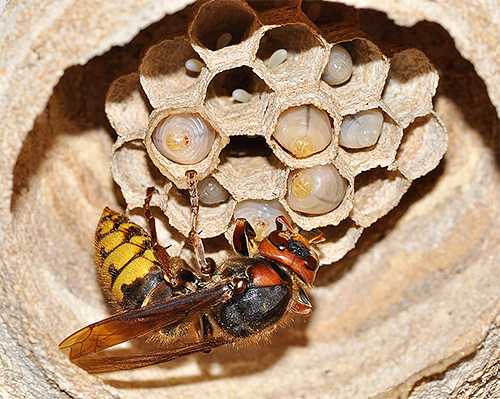
Hornets are practically the largest wasps. Only a few scoli and road wasps can compete with these insects in body length. However, due to their constitution, hornets can still be considered the most massive representatives of the wasp family.
As a rule, hornets live in any biotopes and are in no way associated with human settlements and agricultural lands. The hornet eats different foods, but in general, these wasps can be described as predators. The basis of their diet and food for brood are other insects, which hornets catch in large quantities in the areas around their nest.
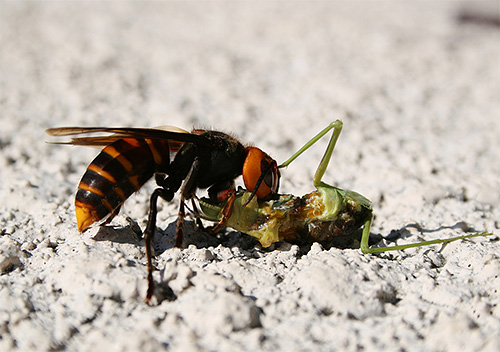
Respectively, where the hornet lives, bee colonies cannot feel safe either. That is why for beekeepers these insects are a real disaster.

However, despite all of the above, with the regular detection of large wasps with a red head on your site, you should first figure out what the hornets eat, where they live, and only then decide on the fight against these insects.
Where do hornets live
To date, science knows 23 species of hornets. These insects can be found in many parts of the globe, but most of the species are distributed in the Northern Hemisphere. Let's take a closer look at the most prominent representatives:
- The European Hornet species includes almost all hornets that are found on the territory of Russia. Representatives of this particular species are most similar to ordinary wasps, but at the same time they can boast of larger body sizes.

- For Asia, the southern part of Europe, North Africa, as well as the Asian part of Russia, the Oriental Hornet is common. This insect has a more original coloration with a completely brown body and a wide single band on the abdomen.

- Among the numerous species of hornets, there is one endemic. Only in the Philippines can you find this deadly insect for humans. The poison of the hornets of this species is so toxic that it occupies almost the first place among all poisonous insects.
European hornets live in forests, groves, in separate thickets of shrubs and in areas occupied by agriculture. The only thing that limits their range is the cold climate in the north and dry biotopes in the south.
Eastern hornets live in other habitats and prefer steppes, semi-deserts, turning into deserts in some places, dry ravines and beams.The eastern hornet is practically the only species that can live in a dry climate.
Hornets live in families in the nests they built. Their dwellings look the same as those of ordinary wasps. A hornet's nest is a round-shaped building made of paper honeycombs, suspended from tree branches or placed in hollows, rock crevices, various human outbuildings, and sometimes even in distribution boxes or mailboxes.

It is interesting
Hornets are capable of causing serious damage to young trees, literally gnawing at their upper shoots while collecting bark to build their nest. Ash plantings are especially affected by hornets - with an abundance of insects, the tops of the trees can be completely gnawed, because of which growth stops or the crown is formed incorrectly.
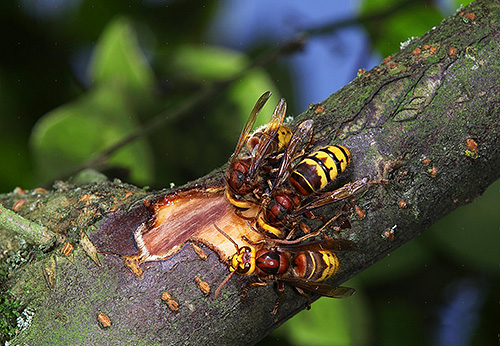
The location of the future nest is determined by the founding female. She hibernates in any secluded shelter, and in the spring, either directly in it, or in a specially found other place, she lays several eggs and feeds the wasps hatching from them. After the birth, young hornets themselves build a large nest and take care of the new brood.
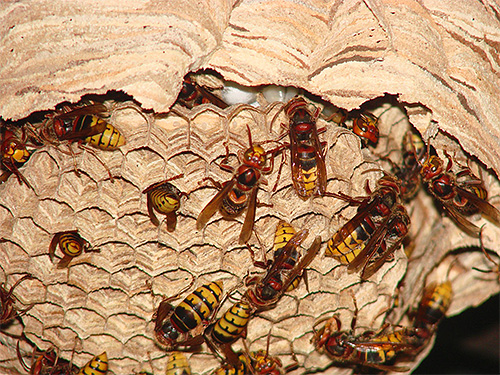

On a note
Hornets are very fond of building nests in toilets, sheds, under the roofs of verandas and summer kitchens. The reason for this is simple - there is no direct sunlight and drafts, it is usually quite quiet and calm. Sometimes hornet nests were found in cars that had not been used for a long time, inside concrete lighting poles, in chimneys.
In general, residents of megacities encounter these insects much less frequently than residents of rural areas.If you figure out what the hornet eats, it becomes clear why - in an area built up with high-rise buildings, even a relatively small nest cannot always be provided with the right amount of food.
Feeding the largest wasps
The basis of the diet of hornets are other insects, spiders, worms, centipedes and slugs. Their hornet eats in the nest, carefully butchering and eating the fattest parts. Hornets feed most of the insects they catch to their larvae - at this stage of the life cycle, wasps are obligate predators, i.e. eat exclusively animal food.

At the same time, adult hornets feed on berry juice (they are especially partial to blackberries, raspberries and strawberries), sweet soft fruits such as peaches and plums, honey, syrup, aphid secretions, meat and fish. Pretty much any strong, natural smell of missing food attracts them. Summer residents should take this fact into account and try to prevent the appearance of such potential food on their site, because even the most ordinary rotting apple can serve as a wonderful food for a hornet.

The real find for the hornet colony is the family of honey bees. Not only are bees themselves very tasty for hornets, and wasps hunt them, sometimes chasing them at a distance of up to 5 km, but the contents of bee dwellings are an equally valuable food resource.
In a plundered hive, the hornet feeds on honey and larvae - this is a sufficient source of food for the hornet family for the entire season. It is not surprising that there is a constant war between hornets and beekeepers.

It is interesting
A giant Asian hornet, reaching a length of 5 cm, can kill up to 40 bees in a minute.And a detachment of hornets numbering only 30-40 individuals is capable of destroying the entire multi-thousand bee colony in a few hours.
An interesting feature of the hornets is that when extracting insects, they do not use a sting, as, for example, ordinary wasps do, but kill their victims with powerful jaws. The hornet poison is used only for self-defense.
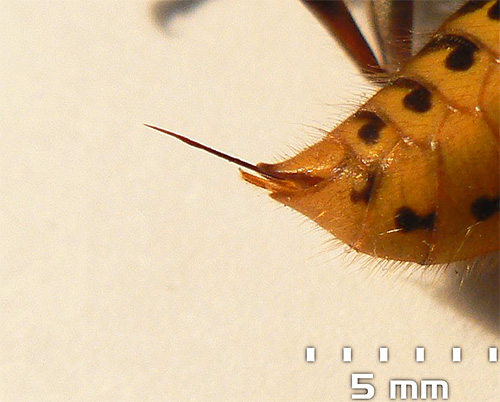
And yet, despite all the troubles that close proximity to a hornet can bring, it’s worth first to figure out how much the nest that appeared in the summer cottage interferes. Hornets are not aggressive insects, and if they do not climb into the nest itself, they will not sting a person. But hornets are quite capable of destroying a fair amount of pests in the garden.
The life of a hornet's nest
The nest of hornets at different stages of construction may look different. In the beginning, it resembles a pear. Later, a lampshade appears at the “pear”, and it becomes like a chandelier.
At the next stage of construction, the "lampshade" lengthens, and its lower edges close, again forming a "pear", but already much larger. At all stages of construction, combs and chambers in which larvae grow are visible in the nest.
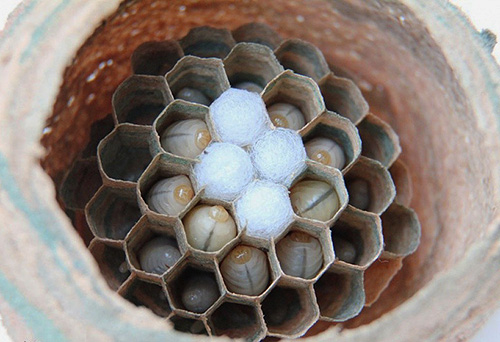
Adult hornets spend only night hours in the nest, and also rest a little here between raids for food or building material. In addition to the hornet workers, there are several wasps in the nest, which are only engaged in cleaning the combs and caring for the larvae, but they are a minority.
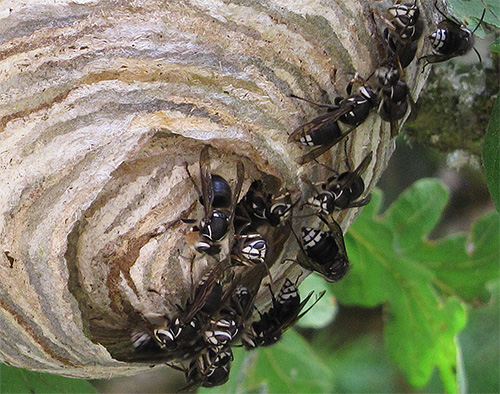
An important point in the life of the nest is that a large number of the remains of the victims of the hornets and the dead wasps themselves constantly accumulate under it.Dead-eater beetles, mites and various parasites settle in this organic garbage, which, at the end of the existence of the nest, climb into the honeycombs and infect the family. In many cases, the nest dies out precisely under the pressure of parasitic mites.
It is interesting
In the nests of hornets, rove beetles and their larvae almost constantly live. They feed on the remnants of the hornet meal, the larvae of their "neighbors" and various nest waste. Regardless of the hornets, these beetles cannot live.
How hornets breed
Hornets reproduce in much the same way as other social hymenoptera.
Mating hornets occurs at the end of the warm season of the year - in the middle latitudes it is August-September. By this time, the family becomes quite numerous, and the nest can reach 70 cm in diameter and 1 m in length.

At a certain point, the uterus begins to lay eggs, from which males and females are already capable of mating (all working hornets are females that are not capable of reproduction).

When the number of mature individuals in the nest becomes very large, they fly out, swarm and mate.
After swarming, the males die within a few days. Females, on the other hand, never return to their native nest, but are looking for a secluded place for refuge, in which they will wait for spring and give rise to a new family.
Worker hornets do not live long - about 3-4 weeks. At the same time, many of them die much earlier when meeting with other predators, being eaten by birds or at the hands of humans.
The life expectancy of the uterus of hornets is approximately one year. She usually dies before the second winter in her life, when young females from her family leave the nest.

Male hornets have the shortest life expectancy.They live from several days to several weeks, depending on how long before swarming they appeared.
Wintering: who from the family is experiencing it?
As mentioned above, hornets hibernate in secluded shelters: dwellings of other insects, bark crevices, hollows, cracks in rocks, under stones, in rural toilets between boards.
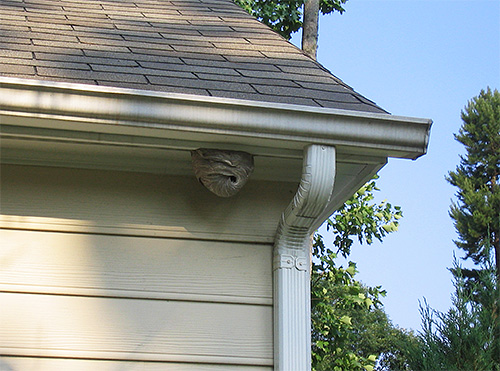
Having dealt with the peculiarities of hornet breeding, we can conclude that only young females winter from the whole family, ready to found a new family at the beginning of next year. Old females almost always die before their second wintering, just like males and worker hornets do.
It is quite obvious that hornets that live near human habitation cannot be considered unambiguously harmful or dangerous insects. They rarely sting, and in general they are calm, and sometimes even useful neighbors. in our gardens, hornets feed on various pests. Only for beekeepers, these insects are unambiguous enemies.

It should also be noted that due to the unreasonably frequent, useless destruction of nests in many regions of our country, hornets have become rare, in some places even listed in the Red Book of insects. Therefore, if the hornet's nest is located in such a way that it does not bother anyone in particular, it should be left alone.
Interesting video: the hornet uterus begins to build its nest alone

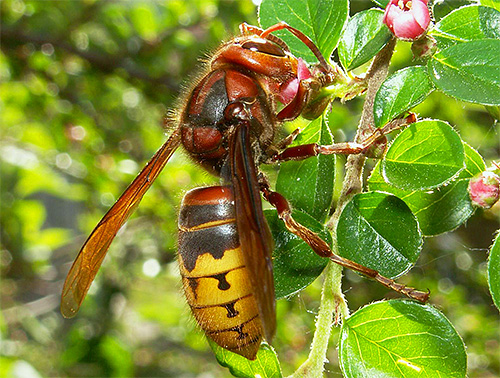

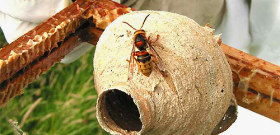

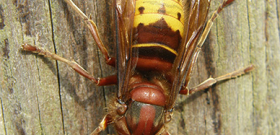
We are already tired of calling the sanitary and epidemiological station to get these creatures out. They constantly wind up between floors, under balconies in the walls.
Marie, are you not creatures?
These hornets are so dangerous, I'm so afraid of them! Already shivering through the body from one word ...
And I plant them in a jar, feed them with grasshoppers and flies.
Tell me, please, what to feed them in the spring when it's cold? ))